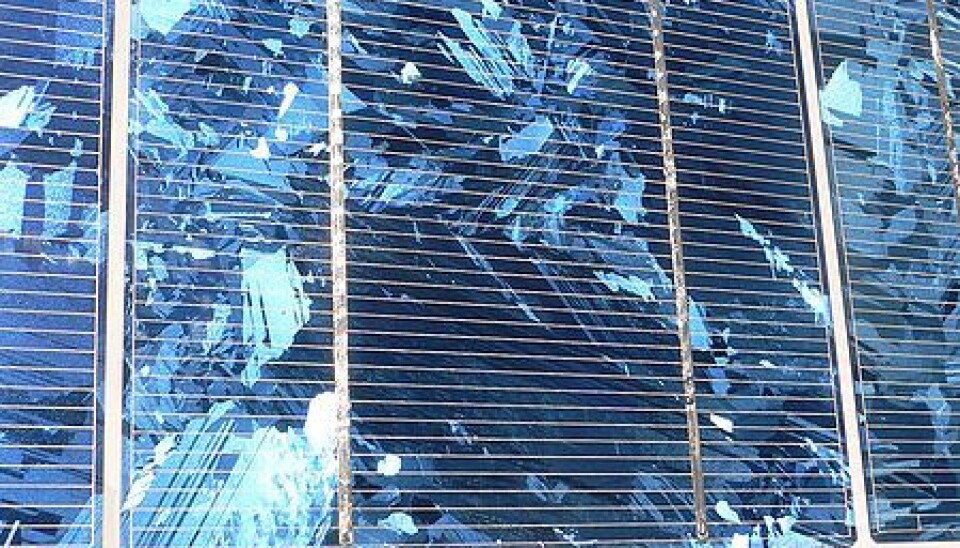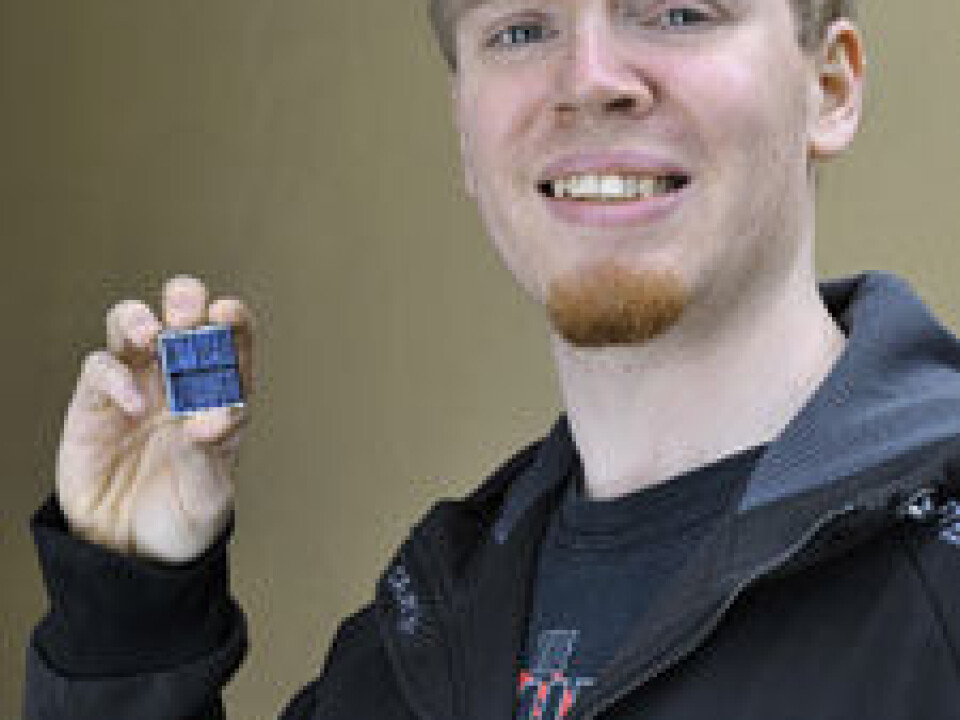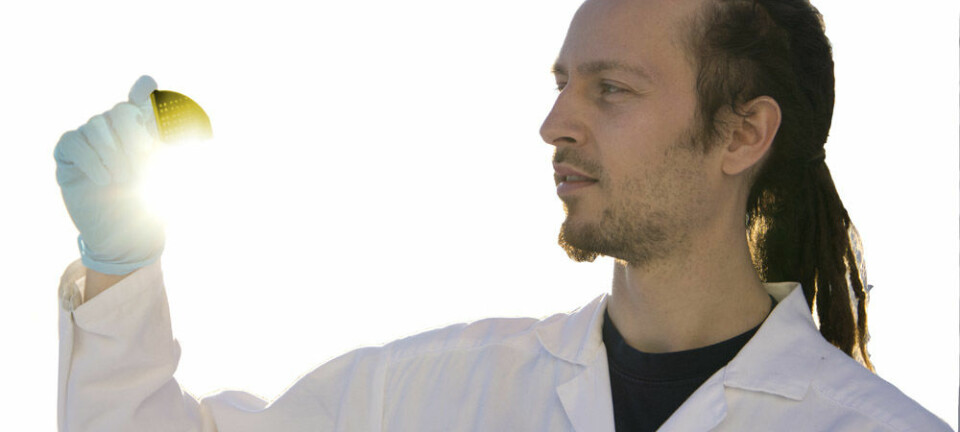
Harvesting energy from all forms of sunlight
By simply cutting UV photons in two, we could get twice the amount of energy from sunlight.
Denne artikkelen er over ti år gammel og kan inneholde utdatert informasjon.
Chris Smith from the Naked Scientists, a British science radio show, recently spent some days in Oslo interviewing Norwegian scientists.
Here he talks to Per-Anders Hansen from the Department of chemistry, University of Oslo.
Per: Sunlight consists of small energy particles called photons and these can have a lot of energy like ultraviolet light or blue light or they can have medium energy like red light or visible light, or they can have very little energy like infrared or heat radiation.
When these photons hit the solar cell, what they do is that they knock loose one electron and this electron can then travel around in our circuit and give us power. And to do this, the photon needs a minimum amount of energy. But if they have more than this, they still only knock loose one electron and this is why solar cells are not more efficient. They could be like two or three times more efficient.

Chris: So if we had a way of taking some of those photons that have very high energy, and converting them into more photons at a lower energy, we could get more electrons out and therefore, the overall efficiency of the cells would be much higher.
Per: Exactly. If you take these high energy UV photons and simply cut them in two, cut the energy in two so we have two particles of half the energy, then you would get twice the amount of power out of those photons.
Chris: Can we do that? Can you convert light of one wavelength like UV into a longer wavelength like that, like you're saying? Is that possible?
Per: Yeah, it’s possible and it’s actually quite easy. It’s easy to turn one photon, one ultraviolet photon, into one visible or one red photon, that's actually quite easy. That's what's going on in fluorescent tube lightings. So that we sort of know how to do. The trickier part comes when you want to cut it in two so that you get actually twice the amount of light or photons out from the ultraviolet light. That's where the trouble is.
We can do that for very high energy photons. That has been done very efficiently. The trick is to do it for photons that actually exist in the sunlight. That, no one has done yet.
Not enough light
Chris: So, we know how to do this for high energy photons like ultraviolet but because there's not much ultraviolet reaching us here at the ground, you're saying that although the materials exist to do it, we haven’t got really the light that can make use of that. So we need a new material that will work with the photons we do have and cut them in this way.
Per: Yeah. We know how to convert very high energy ultraviolet light that exists like in space outside our atmosphere, but the ultraviolet light that comes down to Earth that we get sunburnt off, it doesn’t have enough energy to work with those kind of materials.
Chris: How are you grappling with it? What are you doing to try and overcome that?
Per: Well, I use very peculiar synthesis method called atomic layer deposition. It gives me a very high control of which atoms sit next to each other. You usually have two components in this kind of material, something that absorbs the light you want, and something that emits the light you want.
And you need these to be sort of in every other position, so you have something that absorbs and around it has to sit these emitters and around the emitters, it has to sit absorbers. So, if they are mixed up randomly so that you have one bunch of emitters over there and one bunch of absorbers over there, it’s not going to work. ut if you kind of really control what's next to each other, you have a lot more control of what's going on and the physics that's going on in the material.
Chris: So would that array work because the absorber soaks up the energy and passes it to the emitter next door which then spits out the photons of the wavelength you do want and they're then carried off and absorbed into the semi-conducting material to actually make the current.
Per: Yeah, that's exactly how it will work.
Testing combinations of materials
Chris: What materials can we use? Are you basically trying different combinations of anything to see if you can get the right sorts of absorption and emission or do you already have some candidates that you know are the right sorts of chemicals to use?
Per: Yes, to both. We know what we need. We just need something that absorbs ultraviolet light and blue light, and many things do that so for example, sun cream absorbs ultraviolet light. Sun cream consists of titanium oxide for example. OK, titanium oxide, that could maybe be a good candidate. Then you just need to find something that emits light very well, so then I thought of, ok, what emits red, a TV emits red. In a TV, what is it that makes TV go red is europium.
So, combine those two and that works. So of course, that is not my big secret. My big secret is more fancier than that, but that is kind of the quest you’re going through – just what can absorb it and what can emit what I want and then just combine it. And then you need to combine it in these very particular ways that everything sits at the right place.
Chris: So those atoms are deposited in just the right configuration.
Per: Yes.
50 percent more efficient
Chris: If you can get this to work, what sort of step change in efficiency could we achieve with a photovoltaic? What will it go from to?
Per: Well, a normal silicon solar cell that you can buy on the market today is between 16 and 20% efficient usually, maybe a bit more sometimes. For red light or light between red and 900 nanometres or something like that, it’s actually much more efficient. It’s more like 60, 70, 80 percent efficient.
So, if you actually can take all that other energy, convert it to red light then it’s actually no problem to just take the normal solar cell that you have at your cabin and you suddenly get 50 percent efficiency out of it.
Chris: Which is a dramatic improvement. I think the figure is something like the amount of sunlight that falls on the Earth in one day is equivalent to the amount of energy that the entire world consumes in a year. So if we can get cells up to those sorts of efficiencies, we actually could do quite a lot to offset what we’re concerned about, sort out climate change and all that kind of thing from the energy industry.
Per: Yeah, we have plenty of sunlight. If we can just convert it efficiently and of course, cheaply, then actually we don't really need anything else.
Chris: So, how far away do you think you are from realizing the technology you’re working on? How long before we see these novel coatings going on to photovoltaics so that you can harness the extra energy we’re currently just chucking away?
Per: There is some testing going on now around the world doing this – one ultraviolet into one red or something like that. But this one to two photon cutting, that hasn't been done yet. I hope that we can maybe see that around the world in maybe 5 years, 10 years, I hope.
Chris: So I need to come back in 5 or 10 years and see if you were right.
Per: Yeah, come back then and see how I'm doing.
Chris: I’ll do that.
----------------------------
































